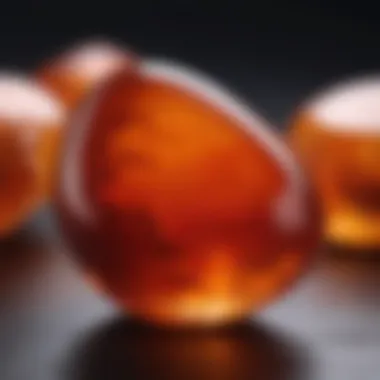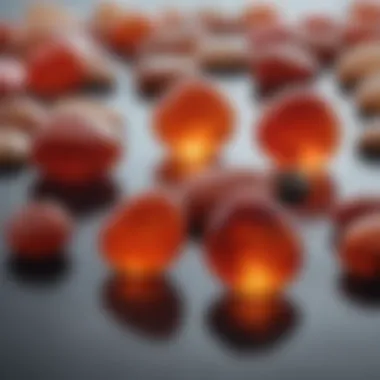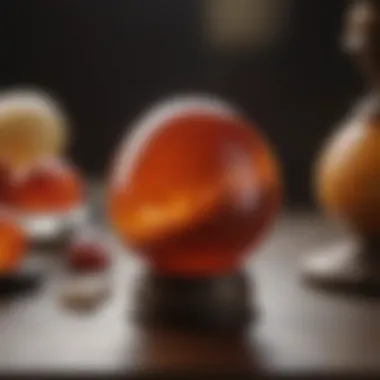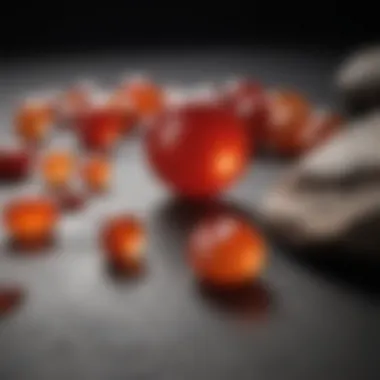Identifying Carnelian: Key Techniques and Tips


Intro
Identifying carnelian, a semi-precious stone, requires an understanding of its unique properties. Carnelian is prized for its vibrant orange to red hues, reminiscent of sunrise or autumn leaves. Knowing how to identify it can enhance any collection. This guide offers insights into recognition techniques, its historical significance, and key physical characteristics.
Featured Collectible of the Month
Overview
Carnelian has long captured the fascination of gem enthusiasts. Originating from chalcedony, a silica mineral, it is often stained with iron, which contributes to its bold color. Its translucency ranges from opaque to semi-transparent, making it an appealing material in jewelry and carvings. Primarily sourced from Brazil, India, and Madagascar, its allure extends beyond aesthetics to its rich historical usage.
Historical Significance
Historically, carnelian has held a substantial place in various cultures. In ancient Egypt, it was used in burial rituals, believed to protect the deceased during their journey to the afterlife. It also played a fundamental role in Roman and Greek societies, often used for signet rings and amulets. The significance of carnelian endures today, making it not just a gem, but a tangible connection to history.
Identification Techniques
Visual Characteristics
When distinguishing carnelian from similar stones, consider the following visual traits:
- Color: Rich shades of orange to red; look for smooth gradations.
- Translucency: Varies from opaque to semi-transparent; light should pass through the stone when held against it.
- Surface Texture: Typically polished, carnelian should be smooth with no rough blemishes.
Resources for Identification
Learning to identify carnelian accurately can be enhanced using several resources. Books on gem identification are invaluable. Online communities, such as the forums found on Reddit or specialized groups on Facebook, provide real-time advice and experiences shared by collectors.
For a more academic approach, resources like Britannica or articles on Wikipedia can offer additional context.
"Understanding the nuances of carnelian elevates your collecting experience, allowing you to appreciate its historical role and beauty beyond mere aesthetics."
Prelims to Carnelian
Understanding carnelian is vital for anyone interested in the world of semi-precious stones. This striking gemstone is lauded not just for its vivid hues but also for its rich historical significance and diverse applications. As you delve into this comprehensive guide, the goal is to provide clarity on how to identify carnelian effectively.
The essence of carnelian lies in its characteristics. Knowing how to distinguish it from similar stones is not just beneficial; it is essential for collectors. Improper identification can lead to purchasing mistakes that may detract from your collection's value. Therefore, it is important to consider various attributes including physical properties, historical context, and unique identifying features.
By equipping yourself with detailed knowledge about carnelian, you enhance your ability to discern its unique qualities. This in turn enriches your appreciation for the stone, making your collecting endeavors more informed and rewarding.
Definition and Significance
Carnelian is a form of chalcedony, a mineral belonging to the quartz family. Its rich reddish-orange tint stems from iron oxide inclusions. This mineral has captivated humanity for thousands of years, appearing in various cultures and traditions.
The significance of carnelian is not solely aesthetic; it is historically regarded as a stone of motivation and endurance. Many ancient civilizations believed it possessed protective qualities. For example, it often adorned the tombs of Egyptian pharaohs, believed to accompany them in their afterlife journey. Collectors today value carnelian not only for its beauty but also for these cultural associations.
Historical Context
The history of carnelian stretches across various civilizations and eras. In Mesopotamia, carnelian was a favored material for seal stones. These seals, used for marking property, were more than practical items; they were symbols of status and power. In ancient India, carnelian was utilized in religious practices, often associated with fertility and prosperity.
**Key periods of significance:
- Ancient Egypt: Often used as amulets and burial items.
- Indus Valley Civilization: Seen in jewelry and trade.
- Roman Empire: Employed in signet rings, showcasing authority.
Understanding the historical context of carnelian aids in appreciating its value beyond mere appearance. Knowing its journey through time enhances the collector's narrative, adding depth to any collection and personal attachment to the stone.


Physical Properties of Carnelian
Understanding the physical properties of carnelian is essential for accurate identification and appreciation of this semi-precious stone. These properties not only help distinguish carnelian from similar stones, but they also reveal insights into the stone’s formation and history. Collectors, whether novice or expert, find value in recognizing these details. Knowledge of physical attributes enhances the experience of collecting and studying carnelian, allowing for informed decisions and assessments.
Color Variations
Carnelian is noted for its rich array of colors, ranging from deep reddish-brown to vibrant orange. Each hue has its specific significance in the identification process. The stone’s color depends on the level of iron oxide present within it. Variations can indicate different origins and formations. For example, a bright orange shade often signals a relatively pure sample. Conversely, deeper tones can suggest higher levels of impurities, which can affect value. When assessing color, it’s crucial to consider the lighting; natural sunlight can enhance the stone's vibrancy, while artificial light may dull the view. Careful observation will reveal the subtleties in color, vital for differentiation from similar stones.
Translucency and Clarity
Translucency is another key aspect to consider when identifying carnelian. This stone typically exhibits varying levels of translucency, offering a window into its clarity and purity. A high-quality carnelian can be semi-translucent, allowing light to pass through, showcasing intricate internal patterns. Impurities and inconsistencies can reduce clarity, providing clues about the stone’s authenticity. Examine the stone against a light source; authentic carnelian will allow some light to pass through but not be entirely clear. Investing time in evaluating translucency can significantly aid in distinguishing carnelian from other stones, helping collectors make informed decisions.
Hardness and Composition
The hardness of carnelian is measured on the Mohs scale, where it typically registers between six and seven. This level of hardness makes the stone quite durable, yet it is still susceptible to scratching. Its composition, primarily silicon dioxide, gives carnelian its distinctive properties. Conducting a simple scratch test with items of known hardness can provide clear identification clues. Testing with materials like a copper penny or a glass plate can determine carnelian's resilience. The results can help ascertain whether the specimen in question is genuine carnelian or another stone masquerading as it.
"Knowledge of a stone’s physical properties is the cornerstone of effective identification and appreciation for collectors. It transforms casual observation into an informed analysis."
Understanding these fundamental physical properties of carnelian is vital for any collector. By focusing on color variations, translucency, and hardness, individuals can accurately identify carnelian in its many forms, enhancing their collection practices.
Identifying Characteristics of Carnelian
Understanding the identifying characteristics of carnelian is crucial for anyone interested in this semi-precious stone. The ability to discern these traits not only enhances one’s knowledge but also equips collectors with the skills to make informed decisions when purchasing or evaluating their specimens. In this section, key identifying aspects such as surface texture, lustre, and striations and patterns will be examined in detail, providing a comprehensive insight into what makes carnelian unique.
Surface Texture
The surface texture of carnelian plays an important role in distinguishing it from other stones. Genuine carnelian typically exhibits a smooth finish. This smoothness is due to the stone’s formation process and can vary slightly among specimens. If you find carnelian that feels rough or exhibits unnatural texture, it may be a counterfeit or a different stone entirely.
To assess the surface texture effectively, hold the stone up to your touch. A natural carnelian stone will feel slightly cool and have a glassy finish. It should lack the bumps or scratches that often characterize lower-quality or imitation stones. Additionally, authentic carnelian often retains its polished surface over time, demonstrating resilience to wear.
Lustre
Lustre refers to the way light interacts with the surface of a stone, and it can provide essential information about its authenticity. Carnelian typically displays a vitreous (glass-like) lustre. This quality is one of the distinguishing features that sets it apart from other red stones, as they may have different types of lustrous finishes.
When identifying carnelian, observe how the stone reflects light. A true carnelian will emit a rich shimmer without appearing too dull or overly shiny. For a more precise assessment, compare your specimen's lustre against known samples. This side-by-side evaluation can help reinforce your understanding of genuine carnelian's lustre.
Striations and Patterns
Striations and patterns can provide further context in identifying carnelian. While this stone is known for its solid color, it can also feature subtle banding or markings that are unique to each piece. These striations can be light to dark, often appearing as slight variations in color or texture.
As you inspect carnelian, pay attention to any distinct lines or patterns present. These features can indicate the stone’s geographical origin or even its quality. However, be cautious; many stones can have similar patterns, leading to potential confusion. Always compare the variation in patterns alongside other characteristics to ensure an accurate identification.
Carnelian is not only appreciated for its beauty but also for its historical significance and use in art and ornaments throughout centuries.
In summary, identifying characteristics such as surface texture, lustre, and striations are indispensable for those looking to effectively recognize carnelian. By cultivating an awareness of these details, collectors will enhance their ability to identify this unique stone amidst its peers.
Differences Between Carnelian and Similar Stones
Understanding the differences between carnelian and similar stones is essential for collectors and enthusiasts. This knowledge not only enhances one's ability to accurately identify carnelian but also broadens the appreciation for gemstones as a whole. Distinguishing features can influence both the value and the aesthetic appeal of these rocks. By honing the skill of identification, collectors can make informed decisions when acquiring stones for personal collections or investment purposes.
Carnelian vs. Agate
Carnelian and agate are often confused due to their similarities in color and appearance. However, there are key differences. Carnelian typically exhibits a warm, reddish-orange hue, whereas agate showcases a wider range of colors, often with notable banding patterns. This banding is a defining characteristic of agate, appearing in layers of varying shades of color.


Moreover, the texture and translucency differ between these two stones. Carnelian is usually more translucent than agate, which can appear to have a more opaque look in certain specimens. When inspecting the surface, carnelian will have a smooth, polished finish, while agate may have a more textured surface, especially if it is in its natural form.
Carnelian vs. Jasper
When comparing carnelian with jasper, one immediately notices the color variations. Jasper is typically more earthy, exhibiting a range of colors from brown to green and even red. Unlike the vibrant and often clear tones of carnelian, jasper is commonly more opaque with a less shinier surface. In addition, jasper often features distinctive patterns that are not prevalent in carnelian.
The hardness of both stones is another distinction. While they both score around 6.5 to 7 on the Mohs hardness scale, jasper tends to be more durable due to its dense composition. This distinction can impact their use in jewelry and decorative items, with carnelian often being used for its more brilliant color and jasper prized for its durability and unique patterns.
Inclusive Comparison with Other Red Stones
Carnelian is part of a broader category of red stones, and understanding its identity requires examining its connections to these other stones. Among these are garnet, ruby, and red tourmaline. Each of these stones has unique properties. Garnet, for example, is generally darker and more opaque than carnelian. Rubies, known for their vivid red color, are actually a form of corundum and are significantly harder than carnelian, rating at 9 on the Mohs scale.
Red tourmaline, also known as rubellite, presents another contrast. It can show a range of shades from pink to deep red, but unlike carnelian, it tends to have more internal fractures, lowering its clarity.
In summary, discerning the differences between carnelian and similar stones is pivotal. Collectors should familiarize themselves with the unique characteristics of each to enhance both their understanding and their collections.
Tools for Identifying Carnelian
Identifying carnelian accurately requires the right tools. The use of proper instruments allows for a more informed assessment. Each tool has its unique benefits, helping collectors distinguish carnelian from similar stones. Knowledge and skill in using these tools can enhance both the accuracy of your identification and the appreciation of the stone's beauty.
Using a Magnifying Glass
A magnifying glass is an essential tool for anyone aiming to identify carnelian. This handheld device magnifies the stone's surface, allowing for a close examination of its features. Look for inclusions and surface imperfections. These can indicate whether the stone is natural or treated. When analyzing carnelian, pay attention to the texture. A genuine stone might have tiny pits or variations that are not present in synthetic alternatives.
To use a magnifying glass effectively:
- Hold the glass close to your eye.
- Bring the stone within a comfortable viewing range.
- Rotate the stone to view different angles.
- Observe any patterns or color variances closely.
A magnifying glass can reveal details that the unaided eye cannot see, making it a valuable ally in the identification process.
Employing a Refractometer
A refractometer serves as a sophisticated yet vital tool in identifying carnelian. This instrument measures the refractive index of a stone, which varies from one type of gemstone to another. Carnelian typically has a refractive index around 1.54 to 1.55. By comparing the measurement with known values for carnelian, one can confirm the stone's identity.
When using a refractometer, follow these steps:
- Clean the stone's surface to avoid contamination.
- Place a tiny drop of water or immersion oil on the prism.
- Position the stone on top of the drop.
- Look through the eyepiece and read the scale.
Note: Ensure you calibrate the refractometer correctly before testing any stones. Incorrect settings can lead to misinterpretation.
Testing Scratch Hardness
Understanding a stone's hardness is crucial for identification. The Mohs scale of mineral hardness can guide collectors in this process. Carnelian ranks around 6 to 7 on this scale, meaning it can scratch quartz but can be scratched by harder materials. Testing hardness involves using a set of reference materials.
To conduct a scratch test:
- Select a known material such as glass or a piece of quartz.
- Lightly scrape the stone's surface against the material in a discreet area.
- Observe any scratches.
If carnelian scratches the reference material, it confirms hardness, supporting its identification. Always take care to perform this test with minimal pressure to avoid damaging the stone.
Using these tools effectively, collectors can not only ensure their carnelian is genuine but also appreciate the stone's unique qualities.
Contextual Factors for Identification


Understanding the contextual factors for identifying carnelian is essential for both novice and seasoned collectors. These factors, which include geographic origin, age, and provenance, help establish a stone's authenticity and value. Recognizing these elements can contribute to a more informed assessment of carnelian, especially in a market where imitations are prevalent.
Geographic Origin
The geographic origin of carnelian plays a significant role in its identity and value. Different regions produce carnelian with distinct characteristics influenced by local geology. For example, carnelian from India often has deeper red hues, while stones from Brazil can exhibit more orange shades. Additionally, regions like Madagascar are known for producing stones with a high level of translucency.
Identifying the source can enhance a collector’s understanding of the stone's unique qualities. Especially, knowing where a carnelian piece originates can guide collectors in evaluating its rarity and significance in the market. You can often find this information from reputable dealers or through certification.
Age and Provenance
Age and provenance are critical when assessing carnelian, particularly in historical and collectible contexts. Older pieces, especially those linked to specific cultures or historical events, can carry significant value. For instance, carnelian has been used in jewelry and seals for thousands of years, particularly in Ancient Egypt and the Indus Valley civilization.
"A collector’s appreciation for carnelian can be enhanced by understanding its geographical, historical, and cultural significance."
Care and Maintenance of Carnelian
Carnelian is not just admired for its vibrant hue and historical backdrop; it also requires proper care to maintain its beauty and integrity. Understanding how to care for and maintain carnelian enhances its lifespan and ensures that collectors can appreciate its qualities for years to come. This section breaks down cleaning techniques and storage recommendations, essential components in preserving your carnelian gemstones.
Cleaning Techniques
Cleaning carnelian is crucial for retaining its aesthetic appeal. However, it’s important to approach this process with care to avoid damaging the stone. Here are a few effective techniques to clean carnelian:
- Gentle Soap and Water: Mix a small amount of mild soap with warm water. Use a soft cloth to gently wipe the surface of the stone. This method will remove dirt and oils without scratching the surface.
- Avoid Harsh Chemicals: It’s essential to steer clear of strong chemicals or abrasive cleaners. These can react negatively with the stone, dulling its color and shine.
- Ultrasonic Cleaners: Some collectors choose to use ultrasonic cleaners with caution. If you decide to use one, ensure the settings are suitable for softer stones like carnelian.
- Drying: After cleaning, always ensure to dry the stone completely with a soft cloth. Leaving moisture can cause damage over time.
Remember to clean your carnelian regularly, as accumulated dirt can obscure its color and brilliance.
Storage Recommendations
Proper storage of carnelian is equally as important as cleaning. Here are some guidelines to follow for optimal storage:
- Use Soft Pouches: Store carnelian in soft cloth pouches or cases lined with fabric. This helps to prevent scratches from other stones or jewelry.
- Avoid Direct Sunlight: Exposure to sunlight can fade the color of carnelian over time. Keep your stones in a cool, dark place to preserve their vibrancy.
- Separate from Harder Stones: Carnelian should be stored separately from harder stones that can cause scratches. Keeping different stones in separate compartments can help to avoid accidental damage.
- Check Regularly: It is good practice to periodically check the condition of your carnelian. Look for signs of wear or damage so corrective actions can be taken promptly.
Maintaining the beauty and integrity of carnelian involves thoughtful care and mindful storage. By adopting these practices, collectors can ensure their stones continue to shine as brightly as when they were first acquired.
Closure and Further Study
Understanding how to identify carnelian is not just an exercise in appreciation of gemstones; it is a pathway to engaging with history and defining one’s collecting practice. This concluding section emphasizes the importance of mastering identification techniques, as it not only enhances your knowledge but also boosts confidence when assessing the stone’s authenticity and quality.
Carnelian holds significant cultural and historical value, and knowing its distinct features allows collectors to connect more deeply with their specimens. It’s essential to remember that expertise in identification can lead to more informed purchases and a greater likelihood of acquiring genuine carnelian. Additionally, being aware of the myriad look-alikes, such as agate and jasper, enriches the collector's ability to recognize and appreciate the nuances that set carnelian apart.
Continuing your education on carnelian is vital. This ensures that as a collector, whether novice or seasoned, you remain informed about developments in the field, including new identification techniques or emerging sources of supply.
Recap of Identification Techniques
In reviewing the identification techniques outlined in this article, several key points emerge that may aid collectors in their evaluations:
- Physical Properties:
- Identifying Characteristics:
- Tools for Identification:
- Color Variations: Recognize the spectrum of colors ranging from vibrant red to brownish tones.
- Translucency and Clarity: Learn to assess the transparency and clarity, which are crucial for identification.
- Surface Texture: Identify the smoothness or roughness of the stone's surface.
- Lustre: Differentiate based on how light interacts with the stone’s surface.
- Striations and Patterns: Look for unique patterns that can help distinguish carnelian from similar stones.
- Familiarize yourself with practical tools like magnifying glasses and refractometers. Each tool offers insight into the stone's properties.
- Test scratch hardness to confirm your observations—carnelian is relatively hard.
Collectively, these techniques create a framework for effective identification. With practice, your confidence will grow, allowing you to assess carnelian proficiently.
Resources for Continued Learning
To further enhance your understanding of carnelian and continue your study, consider leveraging the following resources:
- Wikipedia on Carnelian: A comprehensive overview of the stone’s properties and significance.
- Britannica Articles: In-depth articles regarding gemstones can further educate on related material.
- Reddit Gemstone Communities: Engaging with communities on platforms like Reddit can provide insights and shared experiences from fellow collectors.
- Facebook Groups for Collectors: Various groups dedicated to gemstones allow for discussions and sharing of identification techniques among enthusiasts.



